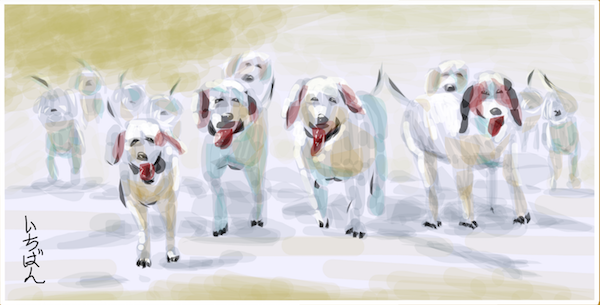
Did you know that the AKC Beagle breed standard includes wording to evaluate a Beagle pack?
The Beagle fancy has never forgotten its roots. Its breed was originally bred to hunt wild hare in packs, and the old English tradition of pack hunting with required livery is preserved – and flourishes – under the auspices of the National Beagle Club.
The Beagle standard includes a Scale of Points when assessing an individual Beagle. A point scale is also used to judge a pack. When judging a pack, the first, if not primary consideration is that the pack present a unified appearance. The hounds must be as near to the same height, weight, conformation and color as possible. A full 40% is given to the “general levelness of pack.”
Since quarrelsome dogs are disruptive, “manners” among the hounds in the pack are also an important consideration. From the standard: ‘The hounds must all work gaily and cheerfully, with flags up–obeying all commands cheerfully. They should be broken to heel up, kennel up, follow promptly and stand. Cringing, sulking, lying down to be avoided. Also, a pack must not work as though in terror of master and whips. In Beagle packs it is recommended that the whip be used as little as possible.” At this point, we should mention that whips aren’t used on the dogs. Whips are used as an extension of the whipper-in’s arm and help keep the hounds focused and organized.
Speaking of “whipper in,” it refers to the person who helps the huntsman during a hunt. In a 1781 treatise written by Peter Beckford, he alludes to the whipper-in being the decisive factor in turning a mediocre hunting day into a brilliant one.He wrote the following in Thoughts on Hunting:
“In a country full of riot, where the covers are large, and where there is a chase full of deer and full of game….I should prefer an excellent whipper-in to an excellent huntsman (italics ours)…. The whipper-in, if he have genius, may show it in various ways: he may clap forward to any great earth that may, by chance, be open [so as to keep the fox above ground]; he may sink the wind [gallop downwind] to halloo, or mob a fox [to slow it down, I presume], when the scent fails; he may stop the tail hounds, and get them forward; and has it frequently in his power to assist the hounds, without doing them any hurt, provided he should have sense to distinguish where he may be chiefly wanted.”
A whipper-in is part of the personnel of a hunt, and thus wears “livery,” the “official” clothing/uniform worn. Again from the breed standard:
Appointments: Master and whips should be dressed alike, the master or huntsman to carry horn- the whips and master to carry light thong whips. One whip should carry extra couplings on shoulder strap.
Recommendations for Show Livery: Black velvet cap, white stock, green coat, white breeches or knickerbockers, green or black stockings, white spats, black or dark brown shoes. Vest and gloves optional. Ladies should turn out exactly the same except for a white skirt instead of white breeches.
It is a subculture within the dog world, and a marvelous one. Owning a Beagle is to be part of a great tradition, and we tip our hat to the Beagle fancy for preserving it.
Image: Beagle Pack © 2016 Ichiban Yada, shared on the licensed under CC-BY which allows for the sharing, coping and redistribution of said material in any medium or format
